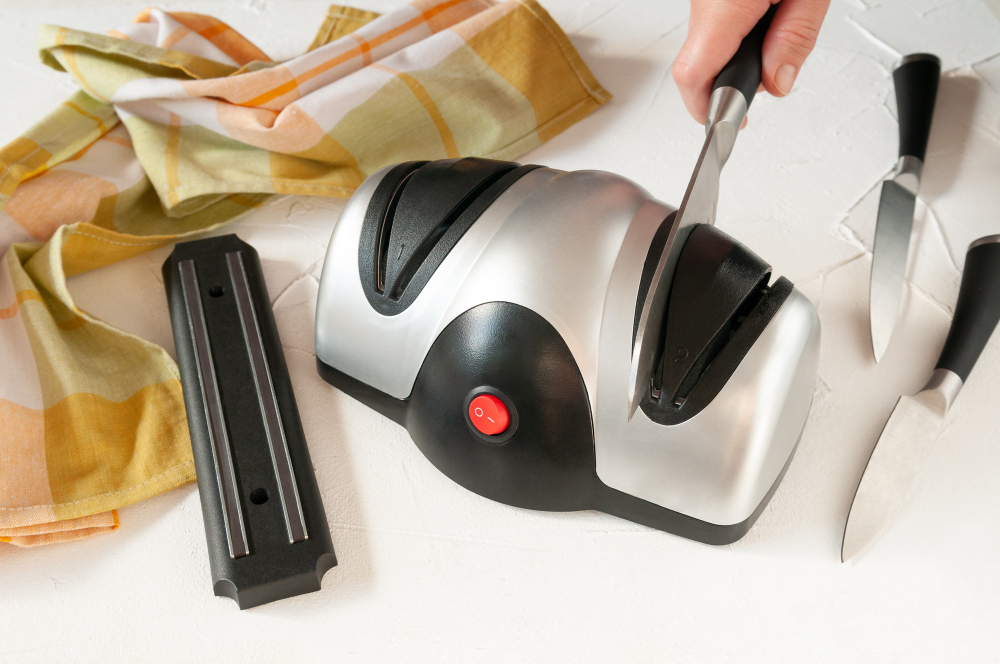In a nutshell, electric knife sharpeners do not pose any direct harm to knives. Like manual whetstones, they need to be used properly so you can gain the most benefit from them. But as for the potential damage, they’re made for knives, after all, so they won’t wreck your knife.
However, using an electric knife sharpener over a manual sharpener won’t provide additional advantages if you don’t understand how knives are sharpened in the first place.
The desire to keep knives sharp makes people ask things like – are knife sharpeners bad for knives, or how long do knife sharpeners last?
Both types of knife sharpeners (manual and electric) have advantages and disadvantages. As a result, if one has the financial means, it is recommended that they purchase both. However, if we must choose just one, we should consider our requirements, and we should also consider our personal preferences.
When picking between the two types of sharpeners, there are a few general aspects to consider. If you’re a beginner cook, you might mistakenly believe that all knives are the same. Knife professionals can show you that this is not the case. The knife’s quality does make a difference.
There are critical differences between Asian and American blades in addition to serrated and straight blades. For example, European and American blades have a 20-degree slant, while Japanese knives have a 15-degree angle. So which knife sharpener you should buy depends on the type of knife you have.
Are Electric Knife Sharpeners Better Than Manual?
Electric knife sharpeners aren’t better than manual, but they’re good at what they are designed to do. So if it’s a toss between getting an electric one and not having any sharpener at home, we recommend that you get an electric knife sharpener.
Below are the benefits of using an electric knife sharpener:
- Electric knife sharpeners, thanks to their abrasive wheels, can restore your blades in a fraction of the time and with less energy than a whetstone or manual sharpener.
- They’re simple to use: Sharpening with electric sharpeners is a breeze. Angle guidelines will be included in the majority of models. Then, all you have to do is insert your knife in the guide and move it across the wheel; the machine will handle the rest.
- They have extra features: If you’re the kind who enjoys gadgets, you’ll like the additional features and functions that come with an electric sharpener. In addition, any decent electric knife sharpener will allow you to sharpen and polish your blades in two steps.
Curious about manual knife sharpeners? Well, these have their peculiar advantages, too:
- Sharpen knives by hand: Manual sharpeners, said, allow you complete control over how fiercely you sharpen your knife. However, if you lose control over the sharpening process, you can damage even expensive knives. As a result, many cooks choose manual knife sharpeners since they can control the pressure and speed themselves.
- They are often less expensive: Even if the most excellent manual knife sharpeners are equivalent to electric ones in price, you’ll find that the majority are significantly less costly. Depending on the store, you can get an excellent manual sharpener for as low as $10. In addition, for $60, you may get a high-quality sharpener.
- They take up less room: An electric knife sharpening will take up the majority of the counter. As a result, the manual version is your best bet. They are often significantly smaller and fit into any drawer. They’re also highly portable, so you can carry them to work with you if you’re a chef.
- They’re perfect for small sharpening jobs: You don’t always need to sharpen your kitchen knives ultimately. Instead, if you own a manual sharpener, you can use it to make tiny adjustments.
Can You Use an Electric Sharpener on Serrated Knives?
An electric sharpener is safe for sharpening serrated blades. Electric sharpeners are less laborious than manual sharpening, but the serrations will wear down over the years if you use electric sharpeners.
To avoid build-up around the sharpening disks, make sure the knife is clean. Use the stages of sharpening in the proper order. If you are only trying to hone the knife and not sharpen it, the majority of knife makers suggest using the fine settings on most machines. For a serrated edge, the fine stage is ideal and recommended; make sure to sharpen only the flat side and not the serrated or scalloped side. When using an electric sharpener, insert the blade from the front, moving it quickly toward you while exerting light pressure to the knife, allowing the knife’s weight to do most of the job.
If it’s a survival knife, the metal used to make it might be tougher to withstand the punishment it’ll receive in the wild. It’s also possible that it has less serration along the blade than a kitchen knife.
Whatever materials your blade is made of, your sharpener must be able to handle it. Having the wrong tool will likely make it challenging to achieve the desired sharpness. It’s also crucial to think about the material, as various fabricators temper steel at different temperatures. As a result, the steel rod must be harder than the blade; otherwise, the steel will be too soft to perform the task.
Make sure the blade doesn’t have any structural flaws. You risk injuring yourself and damaging your equipment by attempting to sharpen it if it has been significantly chipped or the blade has cracked. Keep an eye on the number of knife serrations, too. If the serrated edges are severely worn, you may want to try to return the knife to the maker for refinishing or replacing it entirely.

